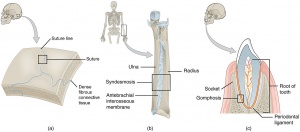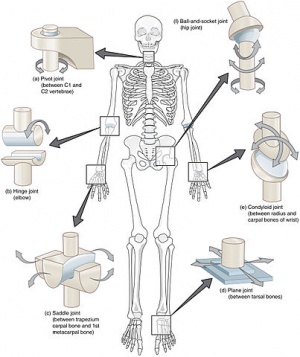Joint Classification
Original Editor - Yasmina Hossam
Top Contributors - Yasmina Hossam, Lucinda hampton, Kim Jackson, Claire Knott and Alexandra Kopelovich
A joint or articulation /articular surface is the connection made between bones in the body which link the skeletal system into a functional whole [1].They are constructed to allow for different degrees and types of movement and are classified by both structural design and functionailty.[2]Some joints, such as the knee, elbow, and shoulder, are self-lubricating, almost frictionless, and are able to withstand compression and maintain heavy loads while still executing smooth and precise movements [3]. Other joints such as sutures between the bones of the skull permit very little movement (only during birth) in order to protect the brain and the sense organs The connection between a tooth and the jawbone is also called a joint, and is described as a fibrous joint known as a gomphosis.
The science of joint structure, function and dysfunction is called Arthrology
Fibrous joints[edit | edit source]
In fibrous joints ,synarthrosis, or synarthrodial joint , the bones are joined by fibrous tissue, namely dense fibrous connective tissue, and no joint cavity is present. The amount of movement allowed depends on the length of the connective tissue fibers uniting the bones. Although a few are slightly movable, most fibrous joints are immovable.
The three types of fibrous joints are sutures, syndesmoses, and gomphoses.
A - Sutures[edit | edit source]
immobile or slightly mobile fibrous joints in which short collagen fibers bind the bones of the skull to each other
Sutures can be classified as:
- Serrate: interlocking wavy lines ( Coronal, sagittal, and lambdoid sutures )
- Lap (squamous): overlapping beveled edges ( Temporal and parietal bones )
- Plane (butt): straight, nonoverlapping edges ( Palatine processes of the maxillae )
B - Gomphoses[edit | edit source]
attachment of a tooth to its socket , Held in place by fibrous periodontal ligament which consist of Collagen fibers attach tooth to jawbone and Allows the tooth to move a little under the stress of chewing
C - Syndesmoses[edit | edit source]
a fibrous joint at which two bones are bound by long collagen fibers , the sepration between the bones and the length of the fibers gives these joints more mobility than a suture and gomphoses
Example of a very mobile syndesmosis: interosseus membrane joining radius to ulna allowing supination and pronation
Example of a less mobile syndesmosis: joint between tibia to fibula[4]
Cartilaginous Joints[edit | edit source]
Cartilaginous joint, amphiarthrosis, or amphiarthrodial joint , two bones are linked by cartilage
Two types of cartilaginous joints:
- Synchondroses
- Symphyses
A - Synchondroses[edit | edit source]
A bar or plate of hyaline cartilage unites the bones at a synchondrosis , The most common examples of synchondroses are Temporary joints in the epiphyseal plates in children which Bind epiphysis to diaphysis and First rib attachment to sternum while Other costal cartilages joined to sternum by synovial joints.
B- Symphyses[edit | edit source]
the articular surfaces of the bones are covered with articular (hyaline) cartilage, which in turn is fused to an intervening pad, or plate, of fibrocartilage, which is the main connecting material. Since fibrocartilage is compressible and resilient, it acts as a shock absorber and permits a limited amount of movement at the joint. Symphyses are amphiarthrotic joints designed for strength with flexibility , y. Examples include thePubic symphysis joins right and left pubic bones with interpubic disc and Bodies of vertebrae joined by intervertebral discs ( Only slight movements between adjacent vertebrae but the Collective effect of all 23 discs gives spine considerable flexibility )
Synovial Joints[edit | edit source]
Diarthrosis, or diarthrodial joint , are those in which the articulating bones are separated by a fluid-containing joint cavity. This arrangement permits substantial freedom of movement, and all synovial joints are freely movable diarthroses , they are the most structurally complex type of joints and are the most likely to develop uncomfortable and crippling dysfunction. Nearly all joints of the limbs and most joints of the body fall into this class.
General Anatomy of Synovial Joints[edit | edit source]
- Articular cartilage. Glassy-smooth hyaline cartilage covers the opposing bone surfaces as articular cartilage. These thin (1 mm or less) but spongy cushions absorb compression placed on the joint and thereby keep the bone ends from being crushed
- Joint (synovial) cavity. A feature unique to synovial joints, the joint cavity is really just a potential space that contains a small amount of synovial fluid
- Articular capsule. The joint cavity is enclosed by a twolayered articular capsule, or joint capsule. The external layer is a tough fibrous capsule, composed of dense irregular connective tissue, that is continuous with the periostea of the articulating bones. It strengthens the joint so that the bones are not pulled apart. The inner layer of the joint capsule is a synovial membrane composed of loose connective tissue. Besides lining the fibrous capsule internally, it covers all internal joint surfaces that are not hyaline cartilage
- Synovial fluid. A small amount of slippery synovial fluid occupies all free spaces within the joint capsule. This fluid is derived largely by filtration from blood flowing through the capillaries in the synovial membrane. Synovial fluid has a viscous, egg-white consistency (ovum = egg) due to hyaluronic acid secreted by cells in the synovial membrane, but it thins and becomes less viscous, as it warms during joint activity
- Reinforcing ligaments. Synovial joints are reinforced and strengthened by a number of bandlike ligaments. Most often, these are capsular, or intrinsic, ligaments, which are thickened parts of the fibrous capsule. In other cases, they remain distinct and are found outside the capsule (as extracapsular ligaments) or deep to it (as intracapsular ligaments). Since intracapsular ligaments are covered with synovial membrane, they do not actually lie within the joint cavity
- Nerves and blood vessels. Synovial joints are richly supplied with sensory nerve fibers that innervate the capsule. Some of these fibers detect pain, as anyone who has suffered joint injury is aware, but most monitor joint position and stretch, thus helping to maintain muscle tone. Stretching these structures sends nerve impulses to the central nervous system, resulting in reflexive contraction of muscles surrounding the joint. Synovial joints are also richly supplied with blood vessels, most of which supply the synovial membrane. There, extensive capillary beds produce the blood filtrate that is the basis of synovial fluid
Besides the basic components described above, certain synovial joints have other structural features. Some, such as the hip and knee joints, have cushioning fatty pads between the fibrous capsule and the synovial membrane or bone. Others have discs or wedges of fibrocartilage separating the articular surfaces. Where present, these so-called articular discs, or menisci , extend inward from the articular capsule and partially or completely divide the synovial cavity in two . Articular discs improve the fit between articulating bone ends, making the joint more stable and minimizing wear and tear on the joint surfaces. Besides the knees, articular discs occur in the jaw, and a few other joints[4]
Types of Synovial Joints[edit | edit source]
Although all synovial joints have structural features in common, they do not have a common structural plan. Based on the shape of their articular surfaces, which in turn determine the movements allowed, synovial joints can be classified further into six major categories ( plane, hinge, pivot, condyloid, saddle, and ball-and-socket joints ).
A - Plane Joints[edit | edit source]
Multiaxial joint , the articular surfaces are essentially flat, and they allow only short nonaxial gliding movements. Examples are the gliding joints introduced earlier—the intercarpal and intertarsal joints, and the joints between vertebral articular processes. Gliding does not involve rotation around any axis, and gliding joints are the only examples of nonaxial plane joints[4]
B -Hinge Joints[edit | edit source]
Uniaxial Joint, the cylindrical end of one bone conforms to a trough-shaped surface on another. Motion is along a single plane and resembles that of a mechanical hinge. Uniaxial hinge joints permit flexion and extension only, typified by bending and straightening the elbow and interphalangeal joints.[4]
C - Pivot Joints[edit | edit source]
Uniaxial Joint , the rounded end of one bone conforms to a “sleeve” r ring composed of bone (and possibly ligaments) of another. The only movement allowed is uniaxial rotation of one bone around its own long axis. An example is the joint between the atlas and dens of the axis, which allows you to move your head from side to side to indicate “no.” Another is the proximal radioulnar joint, where the head of the radius rotates within a ringlike ligament secured to the ulna.[4]
D - Condyloid ( ellipsoidal ) Joints[edit | edit source]
Biaxial joints , The oval articular surface of one bone fits into a complementary depression in another . The important characteristic is that both articulating surfaces are oval. The biaxial condyloid joints permit all angular motions, that is, flexion and extension, abduction and adduction, and circumduction. The radiocarpal (wrist) joints and the metacarpophalangeal (knuckle) joints are typical condyloid joints.[4]
E - Saddle Joints[edit | edit source]
Biaxial Joints , resemble condyloid joints, but they allow greater freedom of movement. Each articular surface has both concave and convex areas; that is, it is shaped like a saddle. The articular surfaces then fit together, concave to convex surfaces. The most clear-cut examples of saddle joints in the body are the carpometacarpal joints of the thumbs, and the movements allowed by these joints are clearly demonstrated by twiddling your thumbs [4]
F - Ball-and-Socket Joints[edit | edit source]
Multiaxial joint , In ball-and-socket joints , the sherical or hemispherical head of one bone articulates with the cuplike socket of another. These joints are multiaxial and the most freely moving synovial joints. Universal movement is allowed (that is, in all axes and planes, including rotation). The shoulder and hip joints are the only examples .[4]
References[edit | edit source]
- ↑ Whiting, William Charles and RuggDynatomy, Stuart (2006) Dynamic Human Anatomy, Volume 10
- ↑ Standring, ed.-in-chief Susan (2006). Gray's anatomy : the anatomical basis of clinical practice. (39th ed.). Edinburgh: Elsevier Churchill Livingstone. p. 38. ISBN 0-443-07168-3
- ↑ Saladin, Ken. Anatomy & Physiology. 7th ed. McGraw-Hill Connect. Web. p.274
- ↑ 4.0 4.1 4.2 4.3 4.4 4.5 4.6 4.7 Marieb, Elaine Nicpon,Hoehn, Katja.Human Anatomy & Physiology. Boston : Pearson, 2012.Ch.8








